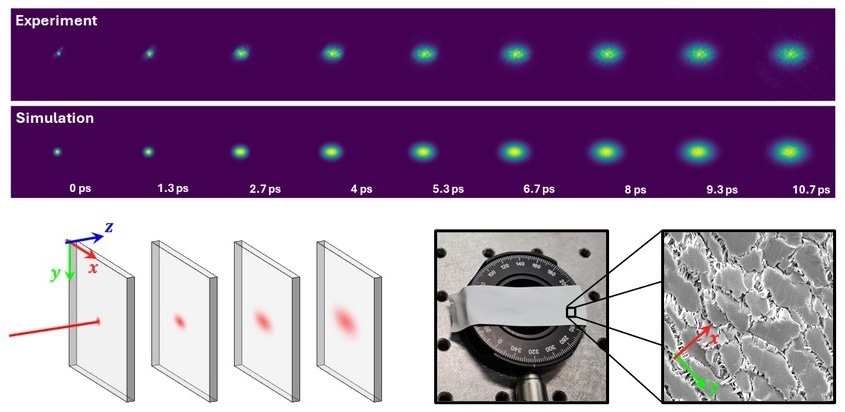Reviewed by Danielle Ellis, B.Sc.Sep 18 2024
Researchers at the European Laboratory for Nonlinear Spectroscopy (LENS) have presented a novel method for the investigation of anisotropic materials in a recent study that was published in Advanced Photonics Nexus.
 Transient imaging reveals direction-dependent light propagation through a scattering medium, in excellent agreement with simulations. The technique enables full characterization of structurally anisotropic materials (e.g., Teflon tape). Image Credit: E. Pini et al., doi 10.1117/1.APN.3.5.056017
Transient imaging reveals direction-dependent light propagation through a scattering medium, in excellent agreement with simulations. The technique enables full characterization of structurally anisotropic materials (e.g., Teflon tape). Image Credit: E. Pini et al., doi 10.1117/1.APN.3.5.056017
For many industries, including manufacturing and medical imaging, it is crucial to comprehend how light moves through different materials. Anisotropy, the directional differences in light scattering that materials exhibit, is a result of the structure. The optical properties have historically been challenging to measure and model with accuracy due to complexity. A novel method recently created by scientists has the potential to revolutionize the understanding of these materials.
The researchers captured the entire complexity of light behavior in these materials by combining sophisticated Monte Carlo simulations with time-domain transmittance measurements.
Teflon tape and paper are two common anisotropic materials that the researchers used to test the method. The practical relevance of Teflon tape, which is widely used in industrial settings, and paper, which is made of aligned cellulose fibers and exhibits structural anisotropy, were considered.
The researchers measured how the light pattern changes over time when materials are exposed to ultrashort light pulses using a transient imaging technique. Together with a novel anisotropy-aware simulation technique, these data provided comprehensive insights into the different ways that light scatters within these materials along different directions.
The investigation revealed significant variations in light diffusion in various directions for both materials, which enabled the researchers to obtain complete scattering tensor coefficients for the first time. The results matched sophisticated simulation predictions, and this level of detail had never been attained before. The results emphasize how crucial it is to take anisotropy into account in material studies because doing so can result in serious errors.
Almost all scattering materials show some form of anisotropy. Yet, many studies have ignored this aspect, assuming materials are isotropic for simplicity.
Dr. Lorenzo Pattelli, Study Lead Researcher, Italian National Institute of Metrological Research (Istituto Nazionale di Ricerca Metrologica; INRiM)
Pattelli added, “Due to this oversimplification, we now know that previously reported scattering coefficients in structurally anisotropic media may be quantitatively inaccurate due to the systematic errors introduced by isotropic modeling.”
The novel technique provides a more precise means of characterizing materials with intricate structures, like biological tissues. This development may lead to enhancements in light scattering-based diagnostic methods, which would be advantageous for material science and medical imaging. With this method, researchers can gain a better understanding and analysis of anisotropic materials' optical properties, opening the door to more accurate applications in a range of academic and professional fields.
Journal Reference:
Pini, E., et al. (2024) Experimental determination of effective light transport properties in fully anisotropic media. Advance Photonics Nexus. doi.org/10.1117/1.APN.3.5.056017